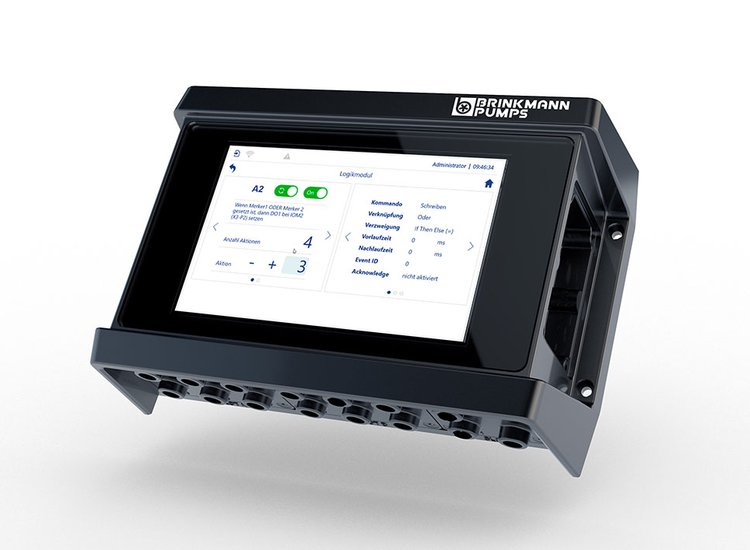
Intelligent pump control facilitates Industry 4.0 entry
After Industry 4.0 and Industrial Internet of Things (IIoT), a new term is making the rounds: Among leading factory planners and thought leaders, there is increasing talk of the trend towards digital shop floor management, which controls, regulates and stabilizes all processes at the shop floor level in real time.
Optimal digitization with long-standing process knowledge
Optimal digitization, however, only succeeds when the flow of real processes is known. This is where BRINKMANN PUMPS comes in when it comes to aggregates and filter systems: The manufacturer of technically sophisticated coolant pumps has been producing a broad portfolio of aggregates for manufacturers of machine tools and printing machines as well as the plastics and beverage industries for over 70 years. So the company knows the real process flows and the customers' requirements.

Six top requirements for controllers
But what does the ideal pump control system look like? Key customer requirements include:
- Automation and networkable (IIoT): Easy integration via common interfaces and fieldbus systems into existing control and automation environments
Flexible: Easy linking of the user's know-how with the functions of the pump control
Quickly integrated and deployable: Implement and commission via "plug-and-pump
Openness: Smart collaboration from all network participants without interface issues
Advanced functionality: Use measured values for more advanced functions such as predictive maintenance
Intuitive and easy to use: Trouble-free operability (usability) according to the "look and feel"-principle
The customer requirements are met by the innovative pump controller bplogic, which supports digital services, applications and systems as a building block in the context of IIoT (Industrial Internet of Things) or Industry 4.0 – independent of the respective system infrastructure. The digital controller is connected via common interfaces – such as OPC UA, Ethernet IP or "Modbus over RS485" – e.g. between machines, pumps, filter systems and other components. What speaks in its favor is that it works with all commercially available frequency converters.
Plug-and-pump: Shorter commissioning reduces installation costs
Various functionality characterizes bplogic: Controlling and regulating the pumps is done with customer-specific, preset parameters. The "plug-and-pump" solution reduces installation costs, shortens commissioning and prevents incorrect settings. But the digital controller can do more: Depending on the type of application, it transmits all data, for example to a machine tool or a filter unit, to several pieces of equipment – but also to all of them if required. In this way, it increases the availability and productivity of the plant and ensures the quality of the products. In addition, hardware costs are reduced because less wiring is required and fieldbus interfaces on the frequency coverter are eliminated.
When bplogic "predicts" wear...
An important requirement of users is the use of the control system as an electronic oracle: We are talking about predictive maintenance, which bplogic enables for Brinkmann coolant pumps used: With the help of long-term logging, the control system performs condition monitoring of all operating data in order to warn of failures in good time. This allows maintenance intervals to be integrated into the production process and downtimes to be reduced. In addition, maintenance costs are reduced because the maintenance department only replaces defective components. The user also avoids creeping faults and can always operate his pumps at the optimum operating point: This significantly increases product quality and service life.
Predictive maintenance does not have to be limited to Brinkmann pumps: If the digital controller monitors the entire process, it can warn of failures in piping, flaps, valves and other system components. This even happens sometimes without sensors: The integrated software calculates the volume flow, for example, just by evaluating the measured pressure – without using a special sensor. This function is used by an automobile manufacturer, for example, to detect pipe bursts. Intelligent pump control has also proven itself with suppliers, filter manufacturers and in the automotive industry: Among other things, for sensorless flow display, unloading of control systems, wear detection and remote maintenance, for energy monitoring, energy-saving cascade operation and even for complete control of a decentralized machine supply.
From Big Data to Smart Data
But the digital controller can do more: To ensure that users are always up to date, data and evaluations can be transferred to a company intranet cloud or directly to mobile devices via WLAN. The raw data collected and processed can be used for targeted energy monitoring via data trace. BRINKMANN PUMPS will be happy to support you in evaluating the data. Online or offline data analysis offers new, more efficient ways to optimize production and reduce production costs. The Smart Data analysis also ensures an improvement in sustainability and environmental protection.
Make it simple: Configure instead of programming
But how can a company make the most of the powerful functionality of the digital controller? Does the staff on the store floor now have to take an additional programming course? The answer from Sauerland to this legitimate question is: Configuration instead of programming! Users of bplogic can select logical links (e.g. AND/OR) without any programming knowledge in order to adapt the digital controller to new applications or requirements.
PLC programming not applicable
The principle of "Configuration instead of programming" also simplifies other tasks: For example, if a customer realizes that he no longer wants to run his unit with pressure control but with flow control, or if he only wants to control two pumps instead of three, there is no need for the usual PLC programming effort.
The user interface in fact offers a completely new form of intelligent pump control: There, all characteristic values such as pressures and speeds as well as time elements can be logically linked. However, because even a configurator does not protect against incorrect entries, the digital controller was given an online debugger, which even laymen can use to find errors in the command chain quickly and reliably.